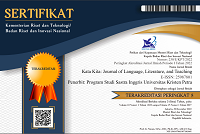Reading the Visual Signs of “Young, Different and Dangerous” in Fashion Spread of NYLON Indonesia Magazine January 2012
DOI:
https://doi.org/10.9744/katakita.2.1.%25pKeywords:
Rekrutmen, Seleksi, Konvensional, metode internalAbstract
This study aims at showing the visual signs used to signify the concept of “Young, Different and Dangerous” in a magazine’s fashion spread. The visual signs are observed by using Dyer’s theory of human signs (1982) and the analysis is focused on the reading of visual signs at two orders of signification, the denotation and connotation. The findings show that the model’s appearance, manner, activity and setting of place are reflections of the magazine’s desired concepts, which suggested by the editor-in-chief. By understanding this, the visual images in fashion magazine, especially NYLON Indonesia, are constructed in such a way to reflect the magazine’s identity and to communicate the magazine’s branding as wellReferences
10 ways to cut up your tee shirt. (n.d.). Retrieved from: http://kentwired.com/10-ways-to-cut-up-your-tee-shirt
Birren, F. (1982). Light, Color & Environment: Revised Edition. New York: Van Nostrand Reinhold Company Inc.
Chandler, D. (1994). Denotation, Connotation and Myth. Retrieved from: http://users.aber.ac.uk/dgc/Documents/S4B/sem06.html
Chau, A. K. (2007). Wearing Certain Color's Can Make You Look Years Younger. Retrieved from: http://voices.yahoo.com/wearing-certain-colors-look-years-younger-569992.html
Crow, D. (2010). Visible Signs: An Introduction to Semiotics in the Visual Arts 2nd Edition. Switzerland: AVA Publishing SA.
Colford, P. (1999, March 3). Nylon Not a Stretch for the Man Behind Ray Gun. Retrieved from: http://articles.latimes.com/print/1999/mar/03/news/cl-13368
Color Psychology. (2013). Retrieved from: http://www.digitalskratch.com/color-psychology.php
Cox, J. (2001, April 6). Sniff, we're Nylon, and we're downtown. Retrieved from: http://www.medialifemagazine.com:8080/news2001/apr01/apr02/5_fri/news2friday.html
dangerous. (n.d.). Retrieved from: http://dictionary.reference.com/browse/dangerous
different. (n.d.). Retrieved from: http://dictionary.reference.com/browse/different
Dyer, G. (1982). Advertising as Communication. London: Routledge.
Felsenthal, J. (2011). Pink Hair Is All the Rage—Just Like it Was in 1914. Retrieved from: http://www.slate.com/blogs/browbeat/2011/05/12/pink_hair_is_all_the_rage_just_like_it_was_in_1914.html
Halid, E. (2012). Letter from the editor. NYLON Indonesia, January 2012, 6.
Jaskolka, A. (2011). The Picture Book of Body Language: The only language in which people can't lie. Berkshire: Foulsham.
Moeran, B. (2006). More Than Just a Fashion Magazine. Currrent Sociology, 54(5), 725-744.
necklace. (n.d.). Retrieved from: http://dictionary.reference.com/browse/necklaces
Nylon Indonesia Januari 2012. (2012). Jakarta: MPG Media.
Patil, S. B. (2012, January 23). Editor In Chief Responsibilities. Retrieved from: http://www.buzzle.com/articles/editor-in-chief-responsibilities.html
Rose, G. (2012). Visual Methodologies: An Introduction to Researching with Visual Materials Third Edition. London: SAGE Publications Ltd.
Svendsen, L. (2006). Fashion: A Philosophy. London: Reaktion Books.
Wyn, J., & White, R. (1997). Rethinking Youth. New South Wales: Allen & Unwin Pty Ltd.
young. (n.d.). Retrieved from: http://dictionary.reference.com/browse/young
Downloads
Issue
Section
License
Authors who publish with this journal agree to the following terms:- Authors retain copyright and grant the journal right of first publication with the work simultaneously licensed under a Creative Commons Attribution License that allows others to share the work with an acknowledgement of the work's authorship and initial publication in this journal.
- Authors are able to enter into separate, additional contractual arrangements for the non-exclusive distribution of the journal's published version of the work (e.g., post it to an institutional repository or publish it in a book), with an acknowledgement of its initial publication in this journal.
- Authors are permitted and encouraged to post their work online (e.g., in institutional repositories or on their website) prior to and during the submission process, as it can lead to productive exchanges, as well as earlier and greater citation of published work (See The Effect of Open Access).














